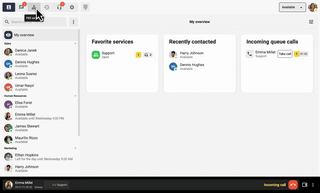While there are many advantages to working from home, there are also challenges, particularly in terms of security. When the WHO classified the coronavirus as a pandemic, businesses had to adapt. This became even more evident during the pandemic, when many companies were forced to undergo a rapid digital transformation. Here we explore some of the security challenges we face when working from home, and how they can be addressed.
Good away but best at home?
Working from home has presented us with a whole new set of challenges, not least in terms of security. However, this transition opens up a lot of risks.
We may be handling confidential information on our own Wi-Fi – or worse – a shared network. At home, or in a coffee shop for that matter, we don’t have the same security procedures. In addition, it can be difficult to keep company secrets from your partner when you both work from home.
Daniel Sörlöv is an Identity and Information Protection Specialist at Microsoft. He believes that there is greater accessibility for hackers today when everyone is connected around the clock, everywhere.

“The IT environment has changed incredibly in recent years and the complexity for those of us working in IT security has increased drastically,” he says.
IT security in the home is now an even more important issue
Due to the rapid pace of change in recent years, many companies have taken shortcuts. This may have resulted in decisions and solutions that expose security gaps. Daniel Sörlöv has seen a clear increase in attacks over the past year, especially against small businesses.
The home, where we otherwise feel most secure, is unfortunately one of the places where sensitive company information is most exposed.
“At home, we work on different devices. We go from desktops at work to the kids’ gaming PC, where people download documents and have meetings. It’s a completely unknown environment for the company. This means that you expose yourself to more risks”, says Daniel Sörlöv.
As there are now devices that the company cannot control, it becomes increasingly important to customize protections.
“We may not be able to take responsibility for any home computer, but we can secure access.”
Open networks and vulnerabilities
What can be even worse than the home network is when people are sitting in a café or staying in a hotel, for example. There, business devices connect to an often unprotected network. A hacker can easily gather information via an access point with the same name and password as the hotel or café network.
“If that signal is stronger, people will connect to my network. Then I can intercept and analyze all the traffic. I can do this in thousands of locations. These access points are easy to operate and hide,” says Daniel.
This can allow hackers to get hold of login information, which can definitely compromise company security.
Read more about it: Telavox makes remote working easier for Lund companies
3 solutions to home IT security problems
So what is the solution to this? What to do when you need to work from home? Daniel Sörlöv recommends three methods:
- Multi-factor
Multi-factor (or multi-factor authentication) means that you need to confirm your login with, for example, e-identification. There are a variety of solutions, from BankID to fingerprints. This way, even a password leak can be stopped. However, Daniel Sörlöv recommends avoiding multi-factor with email, as the verification code may arrive at a compromised email address. - Encryption
Protect and encrypt your databases and documents. However, this requires that the login does not rely only on simple passwords, because then the encryption can be unlocked using these. - Tracking
Make sure to create logs and track changes. This will allow you to see what is happening in your information environment and examine what is normal behavior. This will enable you to prevent future attacks.
Listen to the full interview with Daniel Sörlöv in the Telavox podcast Sweden’s IT Managers.
Telavox – a supplier you can trust
Telavox’s unique UCaaS platform has had a major impact on the Nordic market. The solution consists of a cloud switch, mobile application and interface with telephony, chat, video conferencing, statistics tools and integrations with other systems.
Telavox supports integrations with digital authentication tools like BankID, so you can add an extra layer of security to your customer operations.
Telavox can handle both IT and telecom and is also one of the largest operators in the B2B sector. This way, our customers only need one supplier. We put a strong focus on mobile for all telephony and UCaaS services. Administrators can quickly and easily get started with the app and manage users, costs and data security in a single portal instead of having to log into multiple systems.
With Telavox, users can benefit from automation, better customer service and effective collaboration tools to strengthen both internal and external communication.


